You may have seen the shocking images from Japan in September 2018, including as Osaka’s Kansai International Airport was flooded during the passage of Typhoon Jebi (4 September 2018). The airport was built on an island of reclaimed land, and images also showed a ship that was smashed into the bridge serving as the main link to the airport, fracturing a highway lane and ripping away half the ship’s superstructure.
Less prominent in the following news were reports of the airport being evacuated the next day. Some 3000 passengers and up to 2000 staff had been trapped there overnight, and most had to be transported by boats, with others carried on buses navigating the bridge lanes that remained undamaged. According to Japan Today, passengers complained the airport was under-prepared for such a disaster. Kansai International Airport, one of the busiest in Asia, had been crippled by the storm, and it could take a week before international flights resumed.
To anyone concerned about Hong Kong’s plans for the East Lantau Metropolis (ELM; later dubbed Lantau Tomorrow Vision) – which should be all of us, given the costs and ramifications – the clobbering of Kansai should give pause for thought as to whether the plans have merit, or are a Really Bad Idea.
If you haven’t seen plans for the ELM, you can find them in a rather jaunty document from the Planning Department and the Development Bureau, titled Preliminary Concepts for the East Lantau Metropolis. This outlines ideas for creating one or two new islands in waters between Lantau and Victoria Harbour, and using these to create a new Core Business District and housing for up to 700,000 people.
In July this year, the Our Hong Kong Foundation released an even more grandiose plan, advocating an Enhanced East Lantau Metropolis to accommodate up to 1.1 million people.
Given Hong Kong is prone to typhoons that can bring devastating storm surges, and sea levels are rising with climate change, you might think the potential impacts would be thoroughly discussed in these reports. After all, if a typhoon can cause such havoc on an artificial island with an airport, it’s hard to imagine how severe the impacts could be of a major typhoon slamming an artificial island topped by a metropolis, especially if even a fraction of the million residents require evacuation.
But there’s no such discussion. The “preliminary concepts” document fails to mention typhoons or rising sea levels. The report from Our Hong Kong Foundation has only a superficial consideration of storm surges, suggesting all will be well – in keeping with the rest of the “report”, which is little more than a glossy, frothy brochure, citing five supposedly similar projects that are solely or largely just concept plans, apart from one that has been half-built, and described in the Daily Mail as a “Chernobyl-like ghost town”.
Perhaps this seems nothing to worry about right now, as engineers can surely implement safeguards against storms and rising seas. Yet such measures were implemented at Kansai airport. This was one of the world’s most expensive civil engineering projects, costing around HK$156 billion (US$20 billion) by 2008 – more than double the estimated price tag, mainly as the airport platform sank far more than expected into the compacting clay below. To guard against typhoon storm surges, the platform was designed to be at least four metres above sea level, and ringed with even higher seawalls.
According to the Kansai International Airport Land Company website, in 2004 the airport was struck by a number of huge typhoons, with storm surge waves going over the seawalls and washing out roads. Engineers then raised the seawalls, so they could supposedly protect against an abnormally high tidal surge that could occur once every 50 years.
Yet last week, those walls were breached, and judging from photos were transformed into impounding walls as the airport platform became like an immense reservoir. Which should in turn make Hongkongers leery of readily accepting assurances that engineers can solve future potential issues with the Metropolis Island.
It’s worth investigating well beyond the facade of glossy brochures, to delve into history and climate science regarding the threats and challenges.
First, history. In most readers’ experience, typhoons are little more than an annoyance, or maybe a chance to have a day off work. Yet Hong Kong and the Pearl River Delta perhaps comprise Asia’s worst hit area by typhoons and storm surges, with records such as 17,000 square kilometres flooded and 10,000 people killed in 1245; the sea level rising by around five metres and 10,000 killed in 1874; along with the 1937 typhoon that caused a storm surge and around 11,000 deaths in Hong Kong. Wanda, in 1962, was the last typhoon to hit Hong Kong and bring a major storm surge – raising sea levels in Tolo Harbour by around three metres.
That’s around a metre more than the maximum “wave” anticipated in the Our Hong Kong Foundation report, which blithely bases this notion on an analysis of one, unnamed typhoon. The authors also fail to appreciate that a storm surge is really a local rise in sea level, accompanied by waves whipped by hurricane force winds, like the waves that swamped Kansai Airport.
Nor does the report mention that typhoons may be more intense with climate change, and sea level rise is underway and set to accelerate as ice sheets melt at rates higher than many scientific forecasts anticipated. Hong Kong Observatory projects that by 2100 sea level here could be around a metre higher than today; this is in line with typical global estimates, though some forecasts put the rise at double this. And, whichever figure proves correct, the rise will continue, perhaps for centuries.
So engineers may be asked to go beyond best case scenarios, and raise the island platform. Doing so will in turn add to costs that green groups estimate could be at least HK$500 billion (the glossy brochures lack total cost projections), which is “Even more expensive than the total sum of the third airport runway, express rail and Hong Kong-Zhuhai-Macau Bridge,” according to Thomas Yam Hin-pong, a member of the Citizen Task Force on Land Resources.
Given this would be a massive strain on the public purse, it may be worth noting another lesson from Japan – where, as the San Diego Tribune noted, spending on infrastructure including Kansai International Airport, “yielded painfully little for the rest of the economy.”
Written for the South China Morning Post; published as opinion piece on 7 September 2018 – nine days before Severe Typhoon Mangkhut brought a storm surge to Hong Kong.
Weather including tropical cyclones
Rare November Tropical Cyclones Including Typhoons in Hong Kong
As I write on 13 November 2024, Tropical Cyclone Toraji is set to pass over Hong…
Typhoons and Rainstorms Past Help Hong Kong Forecasts Today
Wetter, Wilder Weather Events Loom with Warming World You may find yourself on a Hong Kong…
“Typhoon to Hong Kong Soon” Makes Great Clickbait
While Hong Kong is sometimes hit by typhoons, predicting them in advance is tricky. Yet this…
Lightning-packed Supercell over Cheung Chau, Hong Kong
Yesterday evening (30 April 2024), weather monitoring imagery showed an intense rainstorm/thunderstorm area – a “supercell”…
Tropical Cyclone Ma-on Headed for Hong Kong
25 August 2022 (evening) update: Ma-on took a track somewhat south and west of earlier forecasts;…
Severe Typhoon Mangkhut highlights perils of massive reclamation by Lantau
Typhoon Mangkhut helped show “storm surge” is a threat to modern cities, not just something for…
Mad Lantau Metropolis Plans Should be Scuppered by Storm Surge Threat
A consideration of science suggests the reclamation plans, including for East Lantau Metropolis are foolhardy, even…
As Hong Kong Sizzles the World Keeps Warming
While climate change may have long seemed an issue for hardcore, tree-hugging environmentalists, concerns are spreading.
Typhoon Haiyan Lessons for Hong Kong
Typhoon Haiyan was among the strongest storms on record, and devastated a swathe of the Philippines.…
Forecasters Benefit from Flights into Typhoons
As well as computer models and weather station info, the Hong Kong Observatory is uses flights…
Hong Kong weather outlook warmer wetter wilder
With global warming only just getting started, according to scientists, it’s time for Hong Kong to…
Typhoon Vicente hurricane force winds blast Hong Kong
Severe Typhoon Vicente slammed Hong Kong on 23 and 24 July 2012, with hurricane force winds…
Severe Tropical Storm Pabuk
Severe Tropical Storm Pabuk looked set to have passed Hong Kong, barely causing an impact other…
HK Number 8 Signal
Hong Kong's Number 8 tropical cyclone warning can be controversial.
Hong Kong Typhoons including Calamitous Storm Surges
Typhoons have sometimes caused massive damage and loss of life in Hong Kong. Just months after…
Hong Kong tropical cyclones
Hong Kong can be impacted by tropical cyclones including and typhoons. Happily, typhoons are scarce near…


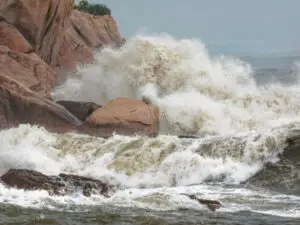
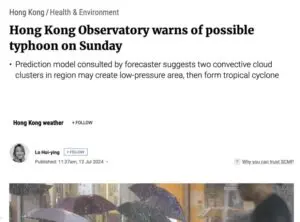
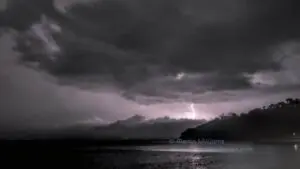
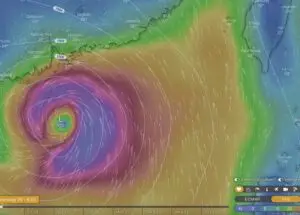

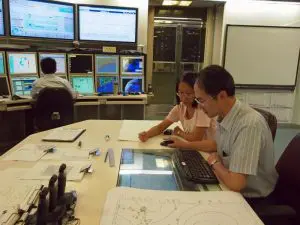
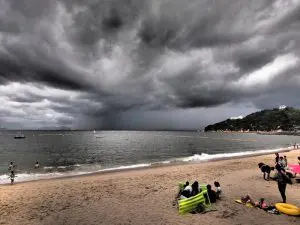
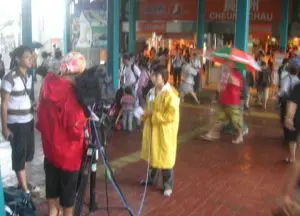

Flooded Kansai Airport and rising sea levels
“Kansai International Airport sits on its own island in Osaka Bay … the airport was built on land reclaimed from the sea to minimize noise pollution and protests over land rights, and designed to withstand storm surges sending seawater 2.7 metres high.
But when Typhoon Jebi hit in September, high waves swept over the walls protecting the airport from the sea, flooding a runway and Terminal 1.
…
Engineers are beginning to restructure airports so that they can withstand flooding, and future airports will need to be built on higher land.
In the US, New York’s LaGuardia Airport received a $28 million grant in 2015 to build a flood wall, pumps to remove rainwater and improved drainage for the runways. Meanwhile Minnesota’s St Paul Downtown Airport now has a 2.4-metre removable wall to protect runways from being flooded by the Mississippi.
Norway is planning to build all airports in future at least 7 metres above sea level”
What a flooded Japanese airport tells us about rising sea levels